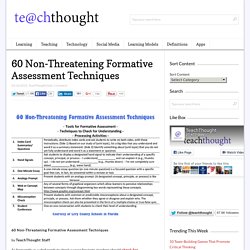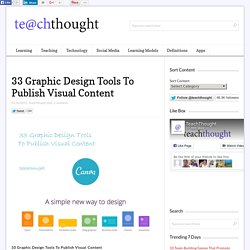

60 Non-Threatening Formative Assessment Techniques. 60 Non-Threatening Formative Assessment Techniques by TeachThought Staff As frequently as a chef needs to check a sauce for taste, teachers should check for understanding.

A Handful of Tools That Help Students Analyze Their Own Writing. Last Saturday I reviewed Analyze My Writing.

That post proved to be one of the most popular posts of the week. It also prompted a bunch of questions from readers looking for other tools like it. Here are some more good tools that students can use to analyze their own writing. Hemingway is a free tool designed to help you analyze your writing. Hemingway offers a bunch of information about the passage you've written or copied and pasted into the site. WordCounter is a simple tool that writers can use to identify the words that they use most frequently in their text. StoryToolz offers a few tools to help you edit your work. Word clouds can help students analyze their own writing by showing them the words that they use with the most frequency in their works. A Dictionary For 21st Century Teachers: Learning Models.
33 Graphic Design Tools To Publish Visual Content. 33 Graphic Design Tools To Publish Visual Content by TeachThought Staff Digital literacy is, in part, about digital publishing.

Digital publishing is, in part, about the writing process–choosing an audience and purpose, drafting content, revising and editing that content, and then sharing it with the world. But digital publishing is also about the right tools for the right platform and the right device. Education is no different; digital publishers in your classroom need the right tools to do amazing things. If you think this isn’t true, sit down to create a book cover with Microsoft Word instead of Adobe InDesign. In an era of digital literacy and digital publishing comes a new genre–visual content. Have You Ever Wondered Why Marijuana Is Illegal? Joe Rogan Brilliantly Summarizes… The Declaration of Independence is PRINTED on hemp paper, yet it's a banned and taboo product...

Ever wonder why? Joe Rogan is one of those activists who has a way of explaining things in a format everyone can understand. Credit: Pinterest And in the brilliant video below, Joe uses his famous means of expression to cover a topic that’s been on many peoples’ minds lately: Why is Cannabis illegal? Hemp is one of the strongest and most durable of all nature textile fibers, is less expensive to produce as paper than trees, and lasts longer than most fabrics and while also being able to withstand harsh conditions. In fact, hemp in its diverse forms is so useful, many people have been wondering why this plant – whose fibers have been used for thousands of years – is so restricted in modern-day times. After you watch the video featuring Joe Rogan below, it might just make sense… What are your thoughts? This article is free and open source. Trending on the Web. 5 Levels Of Technology Integration In Curriculum - The integration of technology in learning is not new.

In the 1980s, many schools had fancy calculators, Macintosh computers, and were even teaching students basic coding. This kind of integration often happened at the lesson or activity level, meaning that it was often surface-level, tacked-on, and perhaps a bit superficial. The power of technology is difficult to fully leverage without curriculum-level integration. This means choosing tools, platforms, and policies based on standards, assessment, and instruction.
A side benefit to this approach is the possibility of teacher collaboration and “same-pageness.” The following technology integration matrix we spotted over on zzwriter.com‘s excellent blog takes a look at this idea of embedding technology at the curriculum level. How to Create Flashcards from a Google Spreadsheet. RefME Web Clipper Makes It Easy to Cite Webpages. Learning Theories: Jerome Bruner On The Scaffolding Of Learning - Learning Theories: Jerome Bruner On The Scaffolding Of Learning by Steve Wheeler, Associate Professor, Plymouth Institute of Education In this post, we explore the work of Jerome Bruner on scaffolding of learning.

This is a simplified interpretation of the theory, so if you wish to learn more, please read the original works. The Theory Bruner’s theory of scaffolding emerged around 1976 as a part of social constructivist theory, and was particularly influenced by the work of Russian psychologist Lev Vygotsky. Bruner believed that when children start to learn new concepts, they need help from teachers and other adults in the form of active support.
27 Ways To Promote Intrinsic Motivation In The Classroom. 27 Ways To Promote Intrinsic Motivation In The Classroom by TeachThought Staff We’ve talked about the definition of intrinsic motivation in the past.

We’ve also talked about some basic ways to improve student motivation. This time, it’s Mia MacMeekin‘s turn to speak to you about the same, but through gridded, blocked, and easy to read infographics. The graphic starts with a definition for both intrinsic motivation and extrinsic motivation, then offers 27 verbs that can help promote that magic stuff that is characterized by curiosity, effort, engagement, and academic success. Some were a little iffy–“praise” and “milestones” seemed a little closer to extrinsic motivation.
Our favorites? 5. 7. 8. 22. 23. 24.